DESCRIPTIONS
and TERMINOLOGY
I
have observed the distinctive use of, or avoidance of various words in item
descriptions. An example of this is "crotch" being described as
gusset, panty panel, shield, open bottom, etc. The words breast and especially
"nipple" are also avoided. (Recently, the term "apex" was
used for nipple.) Even descriptions that advertise breast enhancement bra
inserts (with obvious prominent nipple projections) only mention the
"natural" look.
|
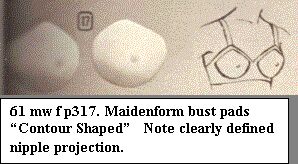

Some
terms may be colloquial, such as use of the term "suspender" in
British areas compared to our term, garter. Another tem that I found puzzling
was a "domed" crotch. (A corrupt mind like mine shouldn't be exposed
to such situations that may lead to wild speculation.) The following two
examples from Eatons (Canada) catalogs 1966 & 1969 state that the garments
have a "domed" crotch.
|

|
|
Robert
Shustack patented a drop-crotch band with three front snaps in 1966 that looks
similar to the Eaton's images. Several other examples were observed in the 1970
Eaton's catalog. The only common characteristic that I could see in the images
was that each used snap closures. Therefore, I conclude that "domed"
is a Canadian (and/or British) colloquial term for snap.
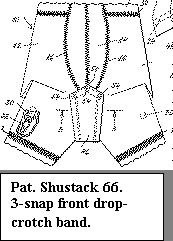
Innovations:
"Slip"
type Girdles:
The
"slip" girdle or "shape-slip" is basically an open bottom
girdle without garters. They have also been offered with an attached crotch and
a snap open crotch. The crotch band is sewn through the front of the garment so
that it is not visible below the hem of the girdle. JC Penny shows an example of
this arrangement in 1992.
|
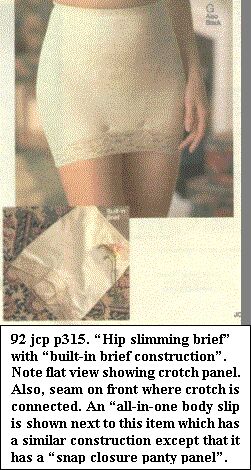
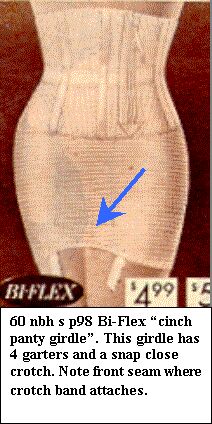
| Most
people today think this is a recent innovation; (reference newspaper article in
the early 90's). However, the
example from National Bellas Hess (1960) shows a garment that could fit right
into today's catalogs (except for garters). This idea appears similar to the
invention by E. Rockwell in 1950 on behalf of the La Resista Corset Co. in
patent # 2,503, 636.
|

|
|
Combinations
with Slips:
In
1970, Montgomery Ward offered a garment with full panty girdle attached under
slip. Earlier, in 1957 Sears advertised a bra-slip with attached garters under
the slip. This would be like a corselet with an attached slip. Aldens showed a
waist cincher with attached petticoat and garters underneath on page 259 in
their Fall 1960 catalog. An inset sketch shows a woman hooking the garters to
her stockings.
|


Interestingly,
the record of patents shows that the idea of combination garments extends back
at least to 1927. That year, Gertrude Nickerson received a patent (# 1,624,558
assigned to Warner's) for a combination slip and top (not really a brassiere)
that included a loose fitting crotch band in the slip. (A forerunner of the
"shape-slip"?) This was
one of the few times I found a patent for clothing that used an image with a
face. Unlike one I included in a later section, this model appears
"unusual" to my late 20th century eyes.
|
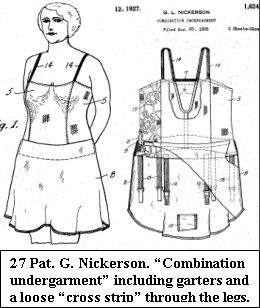

|
.
Terminology:
Open
bottom girdles:
What
is the dividing line between a firm control brief and a girdle? - and the term
"shapers"? I vote for including control briefs and other garments with
panel construction in the category of girdles. The following four headings
represent garments that I think represent the general category of girdles.
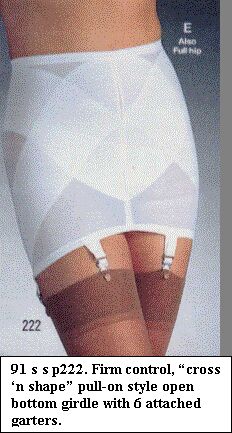 |
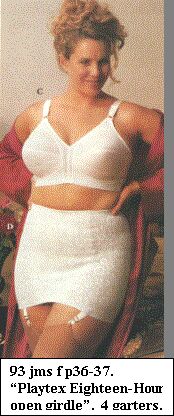 |
|
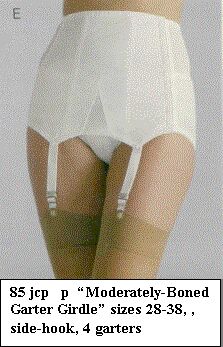
|

Doyle
patented the "Vee" design for the panels in 1957.
The
Girdelette from Lady Grace appears to fall into a subcategory of "garter
girdle".
|
The
term "garter girdle" seems to generally apply to a girdle type garment
(in contrast to a narrow garter "belt") where the hem of the girdle is
above the wearer's crotch.
Long-leg
Panty-girdles:
| Most
long leg panty girdles have tube shaped legs. However, the "Sarong"
design was intended to give more flexibility in walking. The other garments
shown here were selected to illustrate a variety of fabrics, panel arrangement,
and garter placement. Note the difference in garter height among these garments.
The girdle from JC Penny with the garters at the ends of the leg would use the
shortest stockings. The green panty girdle from Sears appears to need very long
stockings - unless the customer was able to buy long adjustable garters to use
with the tabs sewn into the garment.
|
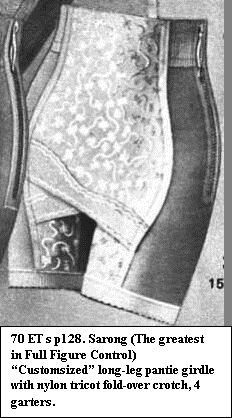
|
|
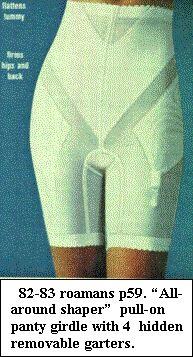
|
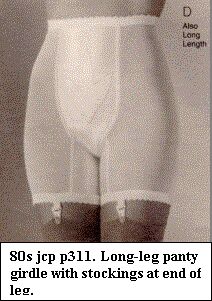
|
|

|
"Brief":
|

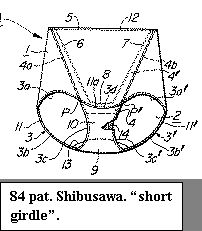
|

This
type girdle is also referred to as a "panty girdle brief".
I don't believe that "garter panties" should fall into this
category because the basic panty garment doesn't appear to be designed for
figure shaping.
This
lovely, full-figured model is wearing a moderate control brief (93-Just-My-Size)
that I feel also should be considered on the fringe of the girdle category.
In
fact, inventor Fox developed a similar style (Pat. # 2,651,777) in 1953 and
called it a panty girdle. M. Shibusawa described this type garment as a
"short girdle" in 1984 for patent #4,476,895.
|
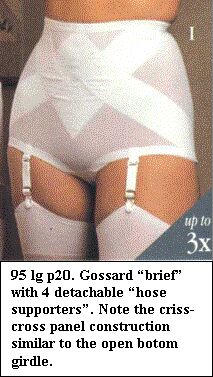
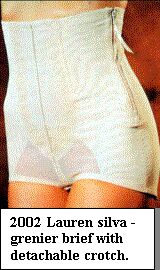
|
"Pants-liners":
The
two examples of "pants-liners" below seem to exhibit many of the
characteristics of girdle construction for the portion from waist to crotch.
|
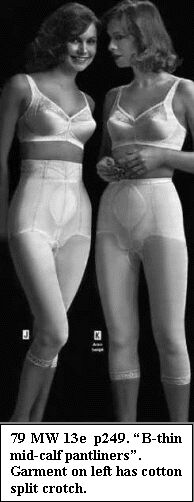
|
I
noticed that there was a lively debate on the Internet several years ago whether
ankle-length "girdles" ever existed. Perhaps in the "trade"
such a garment description doesn't exist. However, copywriters working for
different stores over a period of 44 years (latest was Grenier in 2002) applied
the term "girdle" for this type of garment. From a practical
standpoint, I believe that these represent examples of girdle-like garments
because of the multiple panel structure.
|
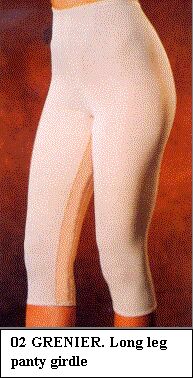
|
|
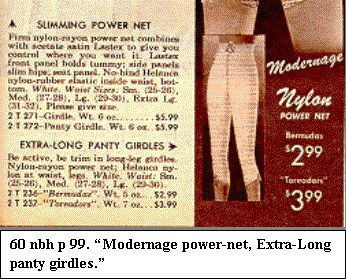
|
This
is an illustration from the 1960 National Bellas Hess catalog, which
specifically identifies the long-leg garment as a girdle. Lane Bryant advertised
a similar, Fortuna "Panti-girdle" on page 79 of their fall 1958
catalog. Montgomery Ward offered a maternity version ("knee-length
maternity panty girdle") on page 307 of their 1963 summer catalog.
|


























